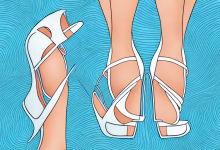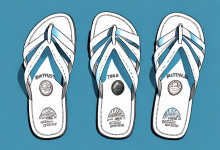Are you looking for an easy way to update your wardrobe but keep your feet safe? Wearing sandals with heels is a great way to elevate your look. However, high heels can be challenging and uncomfortable to wear, and if the wrong fit is chosen, you may find yourself with slipping shoes throughout the day.In this article, we’ll dive into the different types of sandals with heels, how to find the right fit, and some tips and tricks for keeping your feet secure. Read on to learn how to prevent slipping when wearing sandals with heels.
Types of Sandals with Heels
Before you start shopping for sandals with heels, you’ll want to understand the different types of sandals available. A few of the most popular types of sandals with heels include:
- Wedge Sandals: Wedge sandals add height without sacrificing comfort. They typically have a wide sole and offer plenty of support and stability.
- Stiletto Sandals: Stiletto sandals feature a slim heel that tapers down for a more elegant look. These are considered to be more formal than other types of sandals.
- Platform Sandals: Platform sandals offer a bit more cushion than other types of sandals. The thicker sole offers more support and stability, making them a great option for longer events.
- Block Heel Sandals: Block heel sandals feature a wider heel for more stability and support. These are perfect for when you don’t want too much height but still need a bit of extra lift.
Now that you know the different types of sandals with heels, let’s talk about finding the right fit.
Finding the Right Fit for Sandals with Heels
Fit is key when it comes to wearing sandals with heels. The wrong size can lead to blisters, slipping shoes, and all kinds of foot discomfort. When shopping for sandals with heels, make sure you’re trying on pairs that fit snugly but comfortably. Make sure the straps fit well against your skin and do not cut in too much or slide off your foot. Your heel should not slip up or down when you walk. As you walk around in them, check to make sure your toes don’t hit the front of the shoes – if they do, the sandals are too small. Lastly, stand on your tip-toes: you should be able to do so with ease and your foot should not slide around too much in the sandal.Once you’ve found the right fit for your sandal, you can start to focus on the benefits of wearing them and tips for keeping your feet secure.
The Benefits of Wearing Sandals with Heels
Sandals with heels offer a variety of benefits that make them a great wardrobe staple. Not to mention, they’re just a lot of fun to wear! Here are just a few benefits you can enjoy when choosing to wear sandals with heels:
- They offer extra height. You don’t need sky-high stilettos to get some extra lift. Depending on the type of sandal you choose, you can gain anywhere from 1-4 inches of added height.
- They come in a variety of styles. From strappy gladiator options to sleek peep toes, there are plenty of styles to choose from when it comes to sandals with heels.
- They can be dressed up or down. Sandals with heels can take you from the office to evening plans in a variety of ways. Plus, they can even be styled casually with jeans and a t-shirt.
Now that you know the benefits of wearing sandals with heels, let’s move onto some tips for keeping your feet secure.
Tips for Keeping Your Feet Secure in Heeled Sandals
Whether you’re on your feet all day at work or enjoying an evening out, here are some helpful tips for keeping your feet secure in heeled sandals:
- Choose the right size. The size you usually wear may not work for heeled sandals, so make sure you try on the exact size before purchasing.
- Wear socks. Wearing socks or footies will help keep your feet cool and prevent friction inside the shoe. Just make sure your socks aren’t too thick or you may experience slipping.
- Look for straps. Strappy sandals offer more support and stability than slip-ons. If you have narrow or wide feet, look for sandals that offer adjustable straps or velcro fastenings.
- Insert arch supports. Arch supports are a great way to reduce strain on your feet and prevent slippage. They can also help to align your feet so your toes don’t hit the front of the shoe.
- Wear thicker soles. Thick soles offer much more cushion and stability than thin soles. If you want more lift without sacrificing comfort, opt for platform sandals instead of stilettos.
Now that you’re armed with these helpful tips for keeping your feet secure in heeled sandals, let’s move onto adding traction to your heels.
Adding Traction to Your Heeled Sandals
Adding traction to slippery soles is a great way to prevent slipping in heeled sandals. Here are a few easy ways to add traction to your heels:
- Rubber sole protectors. These shoe protectors are designed to offer extra grip and cushioning. To apply, simply remove the adhesive backing and stick them onto the sole of your shoes.
- Non-slip sprays. Non-slip sprays are designed to reduce slipping by adding extra grip to slippery soles. Look for non-toxic sprays that won’t damage your shoes.
- Roughen up the sole. You can also roughen up the sole using sandpaper or a nail file. This will give you some additional grip without damaging the shoe.
- Choose slip-resistant soles. Some shoe brands offer slip-resistant soles that provide extra grip and protection. If you want more traction, opt for these types of soles.
Choosing the Right Socks with Heeled Sandals
Choosing the right socks for heeled sandals is essential for keeping your feet secure and comfortable throughout the day. While thin socks can help with air circulation, they can also cause slipping. We recommend opting for thicker socks or footies made from acrylic fibres or microfibre materials. These types of socks are both breathable and offer extra cushion and support without disrupting the fit of your shoes.
Simple Solutions for Slipping in Heeled Sandals
If you’re still experiencing slipping in your heeled sandals, no worries – there are still a few simple solutions to try:
- Add extra padding. If possible, add some extra padding such as insoles or inserts to the inside of your shoes. This will help fill any gaps between your heel and the shoe, preventing slipping.
- Tighten the straps. Strappy sandals should feel snug but not too tight – adding extra tension to the straps may help compress the foot and keep slipping at bay.
- Choose open-toe styles. If all else fails, try opting for open-toe styles instead of slip-ons. This will help keep your toes from sliding forward when walking.
Taking Care of Your Feet When Wearing Heeled Sandals
Now that we’ve covered some effective solutions for preventing slipping in heeled sandals, let’s take a moment to discuss taking care of your feet while wearing them. While wearing heeled sandals is a great way to add some spice to your wardrobe, it’s important to remember that it isn’t always kind to your feet. If you’re going to be on your feet all day, make sure you take breaks for movement every 20 minutes or so. Choose styles with adequate cushioning and support – never sacrifice comfort for style! Lastly, try applying some rubbing alcohol or talcum spray to reduce friction against your skin and keep blisters at bay.
Conclusion
Sandals with heels are a great way to update your wardrobe while keeping your feet comfortable and secure. By understanding the different types of sandals available and finding the right fit, you can enjoy all the benefits that come with wearing heeled sandals without any slipping or sliding. We hope this guide has helped you find tips and tricks that will help you prevent slipping when wearing heeled sandals!



